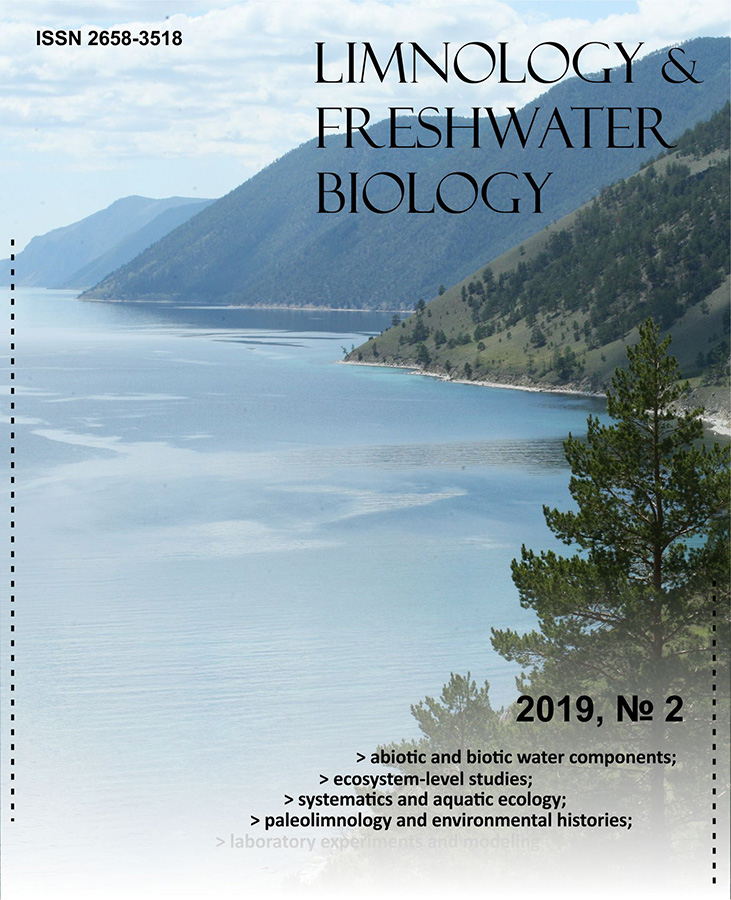No 2 (2019)
Articles
Influence of food on morphological characteristics of Daphnia galeata (Cladocera, Daphniidae) from Lake Baikal
Abstract
The study shows the influence of feeding conditions on morphological characteristics of Daphnia galeata (Sars, 1863) in different areas of Lake Baikal. At high food concentrations and in the absence of invertebrate predators of the species Leptodora kindti, the daphnids have a large body size, low helmets and short tail spines. At low food concentrations, crustaceans with small-sized shells, poorly developed helmets and tail spines dominate. In the presence of the predators, an abrupt shift of adaptive variation occurs: at low food concentrations, the crustaceans have a large body size, and at high ones, small adult daphnids with well developed protective patterns dominate.
 199-204
199-204


The vertical distribution of zooplankton in stratified mesotrophic Lake Arakhley (Eastern Transbaikalia)
Abstract
We have studied the vertical distribution of zooplankton of a stratified mesotrophic lake. Thus, in August 2011 and 2013, copepods dominated the composition of the zooplankton of the mesotrophic Lake Arakhley and had a density maximum either in the upper euphotic layer or in the area of the metalimnion, with a gradual decrease in the lower layers of water. By 2013, the zooplankton community changed and mainly consisted of cladocerans, and they both dominated in numbers.
 205-209
205-209


Microbiological water quality of Lake Baikal: a review
Abstract
The article provides information about the sanitary-bacteriological studies conducted in the water area of Lake Baikal. We show the data on the long-term observations of the spread and abundance of fecal indicator bacteria and potentially pathogenic bacteria in the pelagic and littoral waters of the lake. We also present a review of the standards and methods for the sanitary-bacteriological water quality worldwide, techniques for detecting fecal indicator bacteria, including those specific for human microbiota, methods for microbial source tracking, as well as studies of the spread and retaining of fecal indicator bacteria in various ecotopes, such as bottom sediments and biofilms. For the sanitary-bacteriological monitoring of Lake Baikal, we propose an integrated approach based on the application of modern techniques that correspond to world practice. This approach would allow identification of the sanitary adverse sites and more reliable and standardized assessment of the Baikal water quality.
 210-217
210-217


Changes in diatom and chironomid assemblages of boreal taiga in East Siberia (58N, Lake Aunakit, Russia) during the last 4.2 ka
Abstract
In this study, we analysed a 64 cm long sediment record from Lake Aunakit located on the Kropotkin Range (East Siberia, Russia) for subfossil diatoms and chironomids to provide an improved reconstruction of the environmental changes in the area for the past 4.2 ka. Diatom record is divided into four zones (0-0.84, 0.95-1.25, 1.3-2.0 and 2.0-4.2 ka BP). Duration of chironomid record is 1.8 ka, and this record is divided into five zones 1.8-1.5, 1.5-1.4, 1.4-1.25, 1.25-0.6, and 0.6-0 ka BP.
 218-222
218-222


Phenetic relationships and diagnostic features of sculpins of the genus Cottocomephorus (Perciformes: Cottidae)
Abstract
The author has studied phenetic and taxonomic relationships of the Baikal endemic sculpins of the genus Cottocomephorus Pellegrin 1900. For this purpose, the author has performed a morphometric investigation by five meristic and 29 plastic characters, as well as analysed the characteristics of colouring and the number of preopercular spines. The author has confirmed the validity of three species: C. grewingkii (Dybowski, 1874), C. inermis (Yakovlev, 1890) and C. comephoroides (Berg, 1901). The differentiation of the studied species is based on the number of gill rakers and preopercular spines, the width of the interorbital distance, height and width of the head, the length of the pectoral fins and the characteristics of the in-life colouration. Based on the revision of the diagnostic features, the author has suggested a new key to identify species.
 223-231
223-231











